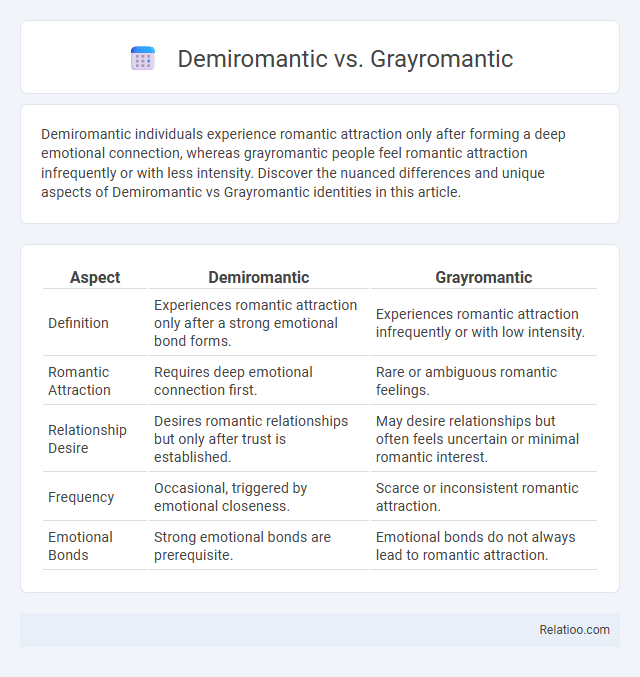Demiromantic individuals experience romantic attraction only after forming a deep emotional connection, whereas grayromantic people feel romantic attraction infrequently or with less intensity. Discover the nuanced differences and unique aspects of Demiromantic vs Grayromantic identities in this article.
Table of Comparison
| Aspect | Demiromantic | Grayromantic |
|---|---|---|
| Definition | Experiences romantic attraction only after a strong emotional bond forms. | Experiences romantic attraction infrequently or with low intensity. |
| Romantic Attraction | Requires deep emotional connection first. | Rare or ambiguous romantic feelings. |
| Relationship Desire | Desires romantic relationships but only after trust is established. | May desire relationships but often feels uncertain or minimal romantic interest. |
| Frequency | Occasional, triggered by emotional closeness. | Scarce or inconsistent romantic attraction. |
| Emotional Bonds | Strong emotional bonds are prerequisite. | Emotional bonds do not always lead to romantic attraction. |
Understanding Demiromantic and Grayromantic Orientations
Demiromantic individuals experience romantic attraction only after forming a strong emotional connection, contrasting with grayromantic people who feel romantic attraction infrequently or with low intensity. Understanding these orientations involves recognizing the spectrum of romantic attraction beyond traditional labels, highlighting how emotional bonds influence romantic feelings differently. This nuanced comprehension supports inclusivity and accurate representation of diverse romantic experiences within the spectrum of sexual orientations.
Defining Demiromantic: What Does It Mean?
Demiromantic describes a person who only experiences romantic attraction after establishing a deep emotional connection, differentiating it from grayromantic individuals who feel romantic attraction infrequently or with less intensity. This orientation falls within the aromantic spectrum, emphasizing the importance of emotional bonds rather than immediate romantic feelings. Understanding your identity as demiromantic helps clarify how you navigate relationships and your unique experience of romantic attraction.
Defining Grayromantic: What Sets It Apart?
Grayromantic describes a romantic orientation where individuals experience romantic attraction infrequently or with less intensity than typical romantic feelings, distinguishing it from demiromantic identity, which involves romantic attraction only after a deep emotional bond develops. Unlike broader sexual and romantic orientations, grayromantic falls within the aromantic spectrum but acknowledges occasional, situational romantic attraction that doesn't fit neatly into traditional categories. Understanding your grayromantic identity helps clarify your unique romantic experiences, setting it apart through its nuance in frequency and depth of romantic feelings.
Key Differences Between Demiromantic and Grayromantic
Demiromantic individuals experience romantic attraction only after forming a deep emotional bond, while grayromantic people fall between romantic and aromantic orientations, experiencing romantic attraction infrequently or with less intensity. The key difference lies in the conditional nature of attraction for demiromantics versus the rarity or ambiguity of attraction for grayromantics. Both terms fall under the broader spectrum of romantic orientation, highlighting diverse experiences of romantic attraction beyond traditional labels.
Signs You Might Be Demiromantic
You might be demiromantic if you experience romantic attraction only after forming a deep emotional connection, unlike grayromantic individuals who feel romantic attraction infrequently or under specific circumstances. Recognizing these signs helps clarify your orientation, distinguishing demiromantic from broader romantic orientations that typically involve more immediate feelings. Understanding your unique romantic pattern can guide your relationships and self-awareness within the spectrum of romantic identities.
Signs You Might Be Grayromantic
Recognizing signs you might be grayromantic involves experiencing romantic attraction infrequently or with low intensity, often feeling uncertain about your feelings or timeline toward others. Unlike demiromantic individuals who only develop romantic attraction after a deep emotional bond, grayromantics may experience fleeting or conditional romantic interests without consistent patterns. Understanding these distinctions helps clarify your orientation and supports your journey in identifying what romantic connections truly resonate with your authentic self.
Common Misconceptions About Demiromantic and Grayromantic Identities
Common misconceptions about demiromantic and grayromantic identities often stem from misunderstandings about romantic attraction as a binary concept. Demiromantic individuals experience romantic attraction only after forming a deep emotional connection, while grayromantic people have romantic feelings that occur infrequently or under specific circumstances, challenging traditional views on romantic orientation. Your recognition of these nuances helps promote accurate representation and respect within the spectrum of romantic orientations.
The Role of Emotional Connection in Demiromanticism
Demiromantic individuals experience romantic attraction only after forming a deep emotional connection, distinguishing this orientation within the grayromantic spectrum where romantic feelings are infrequent or weak. Your understanding of romantic orientation should consider that demiromanticism highlights the crucial role emotional bonds play in triggering romantic interest, contrasting orientations that rely less on emotional intimacy. This focus underlines how romantic orientation spans a range of experiences tied closely to the intensity and presence of emotional connection before romantic attraction emerges.
The Spectrum of Aromanticism: Where Demiromantic and Grayromantic Fit
The spectrum of aromanticism includes various identities such as demiromantic and grayromantic, both representing unique positions within romantic orientation. Demiromantic individuals develop romantic attraction only after forming a deep emotional connection, while grayromantic people experience romantic attraction infrequently or with low intensity. Understanding where you fit on this spectrum can clarify your romantic experience and support your authentic self-expression.
Supporting Demiromantic and Grayromantic Individuals
Supporting demiromantic and grayromantic individuals involves recognizing the unique nature of their romantic attractions, which may be limited or fluctuate over time, distinguishing them from broader romantic orientations. Providing affirming spaces and language that validate their experiences enhances mental health and social connection. Awareness and education help reduce misconceptions, fostering inclusive environments where demiromantic and grayromantic people feel seen and respected.

Infographic: Demiromantic vs Grayromantic
 relatioo.com
relatioo.com